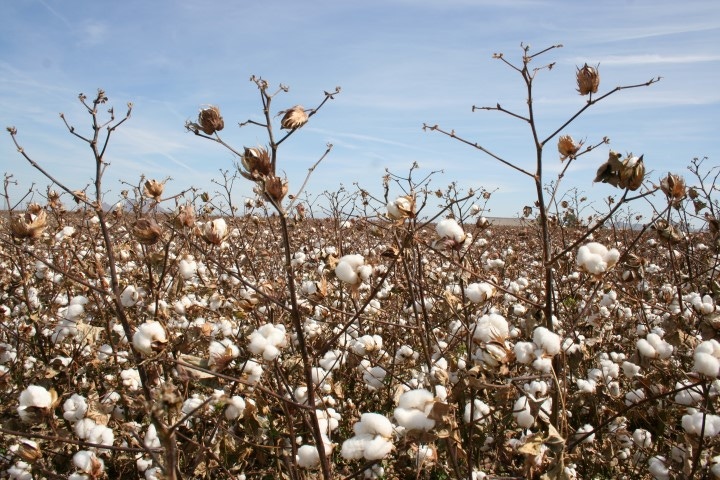
Arizona cotton acreage slides 75 percent in last 22 years
Over the last two decades plus, cotton acreage in the Grand Canyon State has steadily decreased – from 400,000 to nearly 100,000 acres. 2015 Arizona acreage is estimated at 99,000 acres; down 40 percent from 2014's 167,000 acres.
July 4, 2015

In the western cotton industry, the folks who perhaps have the best estimate on planted acreage are those who tabulate grower field data information from pink bollworm eradication surveys.
In Arizona, the ‘cotton numbers man’ is Leighton Liesner, director of the Arizona Cotton Research and Protection Council (ACRC) in Phoenix.
“Right now, we’re tracking more than 99,000 acres of planted cotton in Arizona this year,” Liesner told the cotton industry crowd gathered at the 2015 Arizona Cotton Conference held in Flagstaff, Ariz. in June.
This number is a 40-percent drop from last year’s 167,000 acres; compared to the data Liesner shared at the same conference a year earlier.
Lower overall cotton prices, crop competition, and continued drought are key contributors to reduced acreage in the western section of the Cotton Belt.
Most of this year’s Arizona cotton acreage is in central and eastern Arizona, with reduced acreage planted in western Arizona including Yuma, La Paz, and Mohave counties which border California.
Over the last two decades plus (1993-2015), cotton acreage in the Grand Canyon State has steadily decreased – from 400,000 to nearly 100,000 acres. There were several short-term acreage revivals in plantings during this time, including several years ago when Upland and Pima cotton prices rebounded with a lion’s roar.
Liesner showed a PowerPoint slide which illustrated the overall acreage downturn.
“I hope that we can find a way to turn this around in the future,” the ACPC director said as people’s heads nodded up and down. “If acres continue to fall, there is growing concern over the impact this could have on the cotton industry’s infrastructure.”
This year’s 2015 California cotton acreage in estimated at about 167,000 acres, the lowest level since 1929 prior to the stock market crash.
For 2015, Arizona acreage by type includes: 80,520 acres of Bt cotton, 2,440 acres of non-Bt short staple, and 16,605 acres of Pima long staple. Overall, Bt acreage is down 43 percent from last year and Pima average rose 6 percent.
Last year, Pima plantings soared 800 percent, compared to 2013.
Accordingly, Liesner says this year’s cotton acres have fewer pink bollworm (PBW) and boll weevil ACPC-placed traps - 1,391 PBW traps this year compared to 2,654 last year; and 996 boll weevil traps this year and almost 1,600 last year.
Fusarium Race 4 disease survey results
In other cotton developments, Liesner discussed the results of two ACRPC-conducted cotton grower surveys conducted last year on herbicide resistant weeds and Fusarium Race 4 disease.
More than 4,400 weeds from 100 suspect sites resulted in one new confirmed case of herbicide resistance in cotton.
Inspections for Fusarium Race 4 inspections totaled nearly 4,200 plants from 27 suspect sites with zero positives for Fusarium Race 4.
Cessna to drone
One the ACPC’s major responsibilities is coordinating the regional PBW eradication program. Liesner announced the agency is considering a change from the aerial dispersal of sterile PBW y manned Cessna aircraft to an unmanned aerial system (drone), nicknamed ‘The Desert Cardinal.’
The Desert Cardinal is operated by the M3 Consulting Group through a USDA grant administered by the ACRPC.
"We envision the use of unmanned aircraft systems as a tool to provide rapid response if small outbreaks of pink bollworm occur,” said Nathan Moses-Gonzales of M3 Consulting Group.
“While we hope we never find another pink bollworm here in the southwest, it's nice to know that we'll have this system on hand just in case we need it.”
Liesner showed a short video of the drone dropping ‘oatmeal flakes’ across a field which simulated a sterile moth release.
“UAS technology is something the council and USDA-APHIS have worked on prior to the current craze,” Liesner explained. “We feel confident that for a small initial response area that UAS could be a more timely and economical way to release sterile moths.”
He says drone release could occur within about 48 hours of a small native PBW find.
You May Also Like



